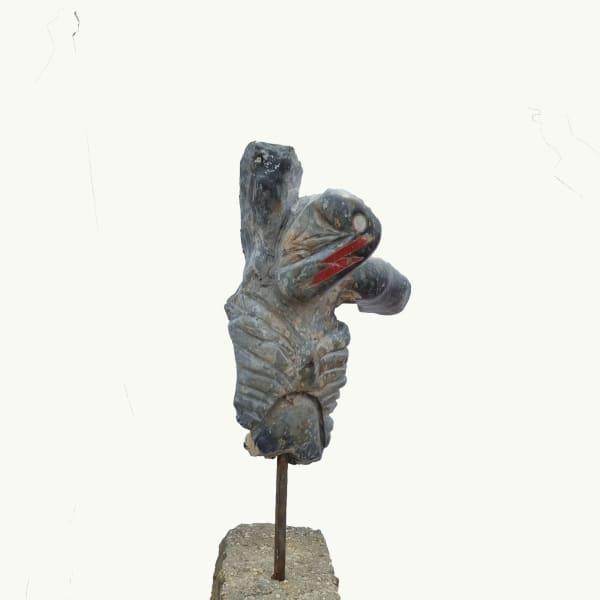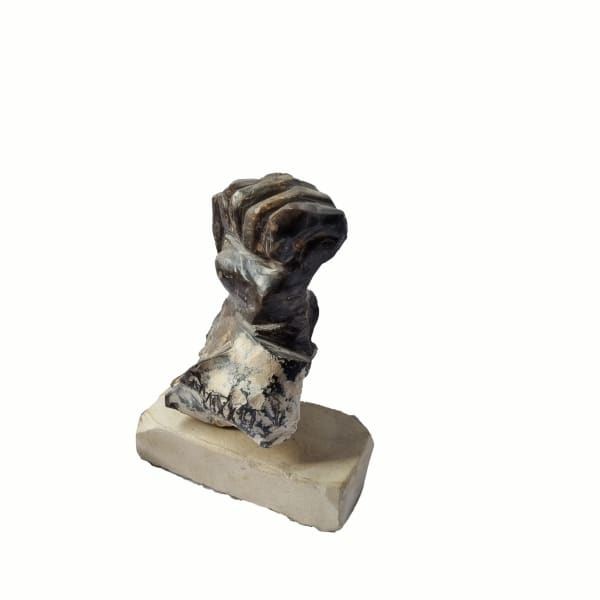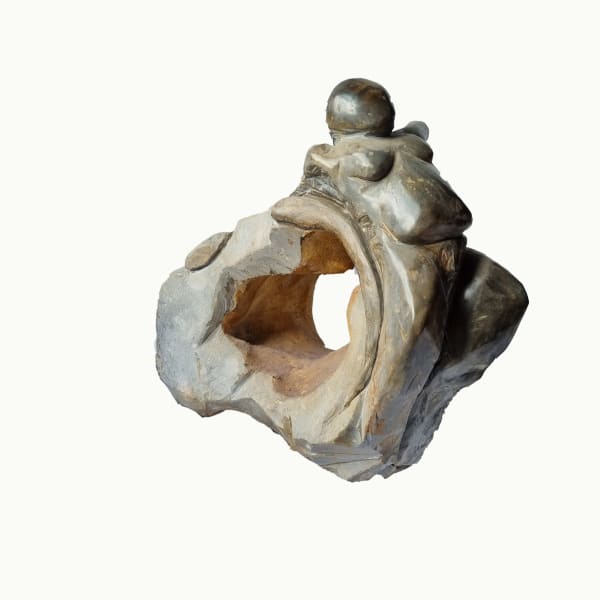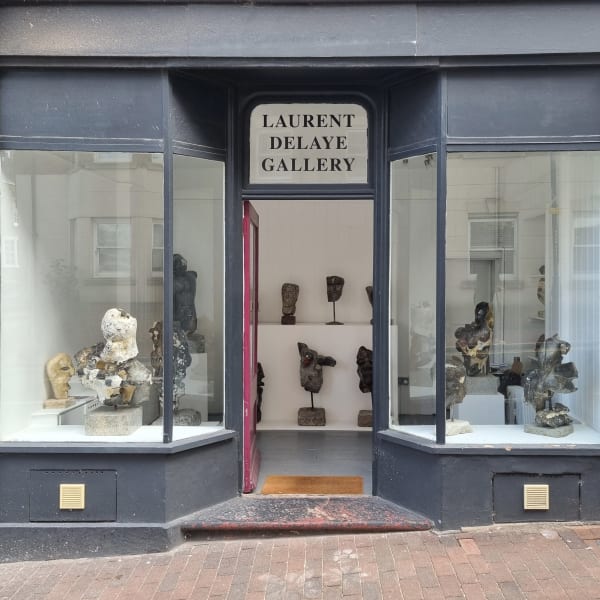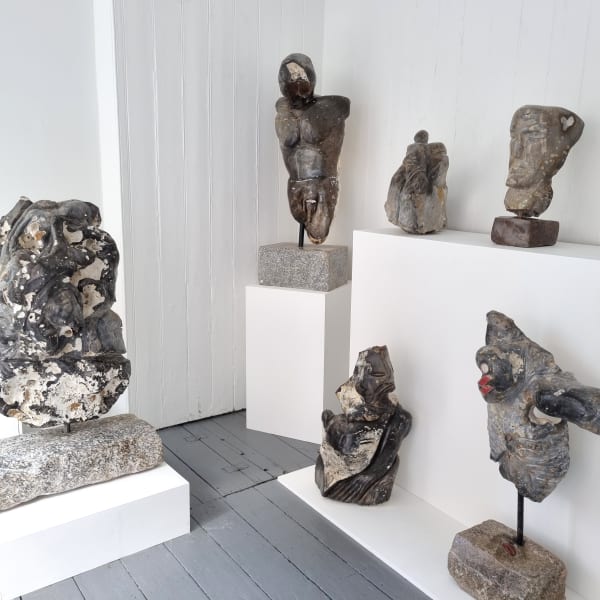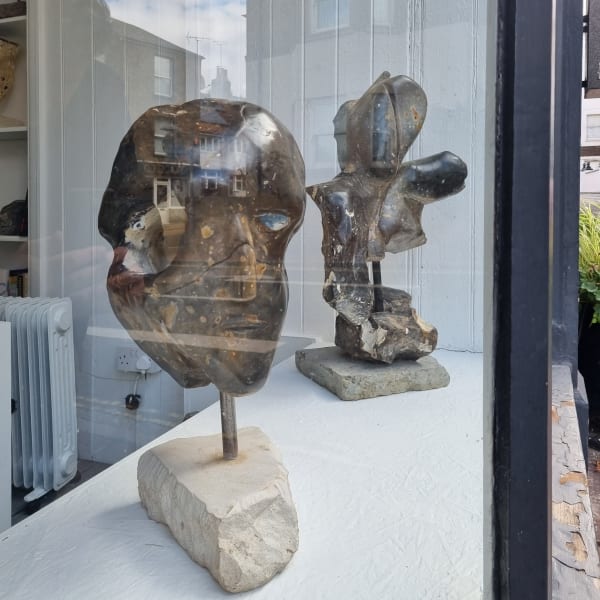Now you can see the universe: Drew Edwards
This show is Drew Edwards first solo exhibition.
Born in 1966, Drew Edwards first trained as an actor before starting his practice as a sculptor at the turn of this century. His journey is one of a self-taught maker who from a very early age followed an urge to sculpt. Initially carving in wood, he progressed to increasingly uncompromising material and his work is now almost entirely produced from flint. For many years Edwards was working as an outsider with no active contacts in the art world. This only changed in recent years when strong bonds of friendship with artists and writers were formed. However, the work retained that same raw pursuit driven by personal compulsions, and the urge to obtain near unattainable forms from unrelenting materials.
Now you can see the Universe refers to an early childhood experience which in retrospect became a foundation to his practice. One day at the age of four, Drew split open a piece of flint. What appeared inside was like the image of a sky at night, with its million configurations of distant lights shining through darkness. It left him with a strong impression which the adult world would not understand. A number of works in the exhibition play with this striking resemblance to cosmology in the appearance of flint itself. One work for example represents a pregnant womb and the dome of the firmament in one single form.
Sculpting flint is an almost impossible undertaking as this material is harder and more brittle than most. Its convoluted shapes are the result of silicified fluid turned hundreds of millions of years ago into one of the heaviest minerals on earth. Our ancestors mastered fire with it and discovered that chipping it would produce extremely sharp tools. It became the primary material that defined the Stone Age and a building block for mankind's nascent civilisations. However, practically no-one can tackle it as a medium for sculpting. There is a clear connection between the ingratitude and beauty of the material and Edwards's obsessive need to extricate forms from it. Extracting massive flint boulders from a mine in Norfolk, Edwards then places them in his home for weeks in order to decipher what the stone will allow him to do. His art emerges from this narrow path between the will to shape and the need to yield, thus informing his practice and adding meaning to his work.
Edwards's work is bound neither to the values of low or high art nor homage to classical forms embedded in our consciousness. While some of his sculpture makes fleeting reference to modernist sculptors of the early and mid-20th century, from Zadkine to Epstein, these visual associations are pure coincidences. Most of the time the figure is the goal, but the stone can relish in pure abstract forms. Some pieces could be mistaken for Neolithic sacred entities discovered by archaeological excavation. Themes are recurrent: organs, skulls, body parts, gaze. The work can sometimes appear to depict clusters of monsters and extreme human expressions or, on the contrary, the calming presence of bare humanity. Whether ironic or literal, autobiographical or engaged in universal narratives, the pursuit is pathos and emotional gravity surging from the toughest matter to overcome. Like the work itself, the artist is not easily categorizable. He could be described as an Outsider in view of his marginal beginnings, but the definition of this term stands in contradiction with his engagement in the art scene today. However, it is also not quite correct to eliminate him altogether from the Outsider spectrum, such has his own journey been: detached from the contexts that normally propel artists in our world.
If there have been interactions with that world, Edwards has taken an unusual path. Two works specifically illustrate this. Firstly, his (anonymous) gift to the Methodist church near Grenfell Tower, which became for many months a sanctuary from this tragedy. The granite elongated figure now stands as a revered symbol of sorrow and consolation at the entrance of the church. Secondly, his monumental Children of the Mediterranean, 2017, a poignant and powerful homage to refugees lost at sea: a large crowd of 91 life-size standing figures of children offered to their cruel destiny, in which the vulnerability of its subjects is paradoxically amplified by the arresting mass of granite. This work is currently exhibited at the Middlesex University Ritterman plinth.
Singular and unclassifiable, Drew Edwards's work is a significant addition to today's contemporary art scene.
-
 Drew EdwardsThey Know, 2020Flint sculpture, metal and concrete base53 x 22 x 24 cm
Drew EdwardsThey Know, 2020Flint sculpture, metal and concrete base53 x 22 x 24 cm
20 7/8 x 8 5/8 x 9 1/2 in -
 Drew EdwardsThe Skull, 2017Flint117 x 52 x 34 cm
Drew EdwardsThe Skull, 2017Flint117 x 52 x 34 cm
46 1/16 x 20 1/2 x 13 3/8 in -
 Drew Edwards, Blake, 2018
Drew Edwards, Blake, 2018 -
 Drew EdwardsCosmos, 2021Flint46 x 24 cm
Drew EdwardsCosmos, 2021Flint46 x 24 cm
18 1/8 x 9 7/16 in -
 Drew EdwardsEmperor, 2017Flint75 x 52 x 38 cm
Drew EdwardsEmperor, 2017Flint75 x 52 x 38 cm
29 1/2 x 20 1/2 x 14 15/16 in -
 Drew EdwardsLibertin, 2018Flint117 x 37 x 42 cm
Drew EdwardsLibertin, 2018Flint117 x 37 x 42 cm
46 1/16 x 14 9/16 x 16 9/16 in -
 Drew EdwardsMiracle, 2019Flint77 x 54 x 32 cm
Drew EdwardsMiracle, 2019Flint77 x 54 x 32 cm
30 5/16 x 21 1/4 x 12 5/8 in -
 Drew EdwardsSmall Putin, 2022Flint43 x 21 x 16 cm
Drew EdwardsSmall Putin, 2022Flint43 x 21 x 16 cm
16 15/16 x 8 1/4 x 6 5/16 in -
 Drew EdwardsStar Man, 2018Flint76 x 37 x 13 cm
Drew EdwardsStar Man, 2018Flint76 x 37 x 13 cm
29 15/16 x 14 9/16 x 5 1/8 in -
 Drew EdwardsThe Great Creator, 2022Flint and lapis lazuli53 x 22 x 31 cm
Drew EdwardsThe Great Creator, 2022Flint and lapis lazuli53 x 22 x 31 cm
20 7/8 x 8 11/16 x 12 3/16 in -
 Drew EdwardsAlter, 2018Flint44 x 50 x 37 cm
Drew EdwardsAlter, 2018Flint44 x 50 x 37 cm
17 5/16 x 19 11/16 x 14 9/16 in -
 Drew EdwardsBowie Star Man, 2018Flint79 x 41 x 26 cm
Drew EdwardsBowie Star Man, 2018Flint79 x 41 x 26 cm
31 1/8 x 16 1/8 x 10 1/4 in
(height includes steel rod) -
 Drew EdwardsBust, 2021Flint54 x 28 x 18 cm
Drew EdwardsBust, 2021Flint54 x 28 x 18 cm
21 1/4 x 11 x 7 1/16 in -
 Drew EdwardsCaged In, 2020Flintheight 71 x depth 33 cm
Drew EdwardsCaged In, 2020Flintheight 71 x depth 33 cm
27 15/16 x 13 in -
 Drew Edwards, you saw the sky in my eyes as we made love Louisiana, 2022
Drew Edwards, you saw the sky in my eyes as we made love Louisiana, 2022 -
 Drew EdwardsWomb, 2022Flint64 x 27 x 24 cm
Drew EdwardsWomb, 2022Flint64 x 27 x 24 cm
25 3/16 x 10 5/8 x 9 7/16 in -
 Drew Edwards, Figure of the Past and Present, 2021
Drew Edwards, Figure of the Past and Present, 2021 -
 Drew EdwardsFist, 2020Flint30 x 14 x 16 cm
Drew EdwardsFist, 2020Flint30 x 14 x 16 cm
11 13/16 x 5 1/2 x 6 5/16 in -
 Drew EdwardsHead, 2021Flint on steel rod and marble base50 x 23 x 29 cm
Drew EdwardsHead, 2021Flint on steel rod and marble base50 x 23 x 29 cm
19 11/16 x 9 1/16 x 11 7/16 in -
 Drew EdwardsRussian Soldier, 2022Flint42 x 21.5 x 22 cm
Drew EdwardsRussian Soldier, 2022Flint42 x 21.5 x 22 cm
16 9/16 x 8 7/16 x 8 11/16 in -
 Drew EdwardsWheel of Life, 2019Flint44 x 44 x 18 cm
Drew EdwardsWheel of Life, 2019Flint44 x 44 x 18 cm
17 5/16 x 17 5/16 x 7 1/16 in -
 Drew Edwards, Monkey, 2017
Drew Edwards, Monkey, 2017













